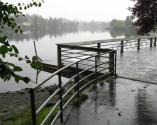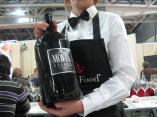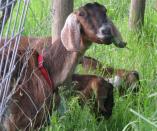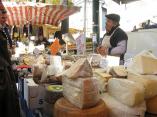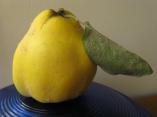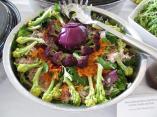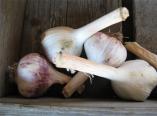We arrived at Viticultors Espelt, a winery in Girona that opened in 2000, and decanted the able-bodied for tour and tasting, while a pair of sufferers and their translators headed to hospital in search of antibiotics for respiratory tract infections.
We were presented with jolly orange sun-hats in which we set off in hot windy sunshine for a look at the vineyards.
It’s a new estate, only aquired three years ago, and the winemakers are busy learning about their terroir, by experimenting with different harvests, agings and blendings. In this baking climate, the plantings are done strategically, matching the varietal to sun exposure, and using stronger vines like grenache to protect more fragile ones like syrah from the wind that blows in from the sea, visible from the hilltop we were standing on. The terraces along the hillside are being restored by dry stone walling, three km achieved in two years, by two people working full time. Global warming is playing its part here, and the harvests are coming earlier each year: traditionally done in mid September, they are now taking place in mid to late August. Such is the heat, the harvest takes place between 4am and 11am, otherwise the grapes would start fermenting in their skins as soon as they were picked.
As we walked back for our tasting, we passed a charming but unremarkable farmhouse, which the winemaker told us was by night a very exclusive and popular disco, Ranch Frank, started by Salvador Dali and his American girlfriend.
We dashed through the tasting – Mareny 2006 (Sauvignon Blanc and Muscat), Quinze Roures 2006 (Grenaches gris and blanc); some nice full-bodied reds, Saulo 2006 (Grenache and Carinyena) and Terres Negres 2004 (Carinyena and Cabernet); and finished off with Airam 1998, a sweet wine made in very limited quantities from Grenache grapes, using the Solera (“fractional blending”) method, which is also used for sherry. It’s aged in half full barriques using a complicated method of adding partially aged wines to the new (in a process I’d be reminded of when we learned about balsamico tradizionale) all of which allows controlled oxidation to leave its mark.
The bus with its slowly reviving occupants arrived and whisked us off to a lively seafront town called Roses,
where we had an excellent tapas lunch – sweet shots of gazpacho; mussels both in a cold vinaigrette and hot stuffed; a gorgeous but too-small school of anchovies in garlic oil; quail eggs;
calimari; octopus; patatas bravas;
and then some noodle-style paella with, of course, allioli, and strawberries and ice cream to finish, all washed down with lots of sangria.
A lucky thing we’d eaten well as we weren’t offered so much as a speck of foam at El Bulli where all hands were busy preparing for supper.
A spectacular and slightly terrifying cliff-side drive from Roses, the much revered restaurant is only open six months a year, and they begin taking reservations from October.
The numbers involved are revealing… of something. In order to assure newcomers a place in the experience (which is around 30-35 small and ever-changing dishes for 185 euros per head plus wine and taxes) they have a policy of booking half the total 8,000 seasonal seats in repeat business and half new diners. There are 1,700 items on the book-like wine list, representing some 19,000 bottles in their cellars, and so the sommelier recommends you consult online before they start pouring into one of the 60 different wine glasses and 5 types of decanters. They have an electronic menu which you can use to filter your wine selections through your 30 food items if you want to complicate your life further; and of course there is a water list to choose from too.
The staff (67) outnumber the diners (50) but are not all paid employees, since there are 45 trainees (4 this year will be selected from 4000 applicants).

Ferran Adria stepped out of the kitchen long enough to engage in a bit of verbal ping pong about what is art (El Bulli is officially known this year as Pavilion G in the German art festival Documenta) and revealed he spends about 30 percent of his time talking to media and conferences.
After one last look at the dandy view from El Bulli’s courtyard, we hopped back on our bus and arrived at Mataro, which Carlo explained was another word for Mourvedre, very appropriate. It was a nice hotel in a bad location – across the road from what I heard was not a great beach, and a couple of kms from town, so taxis were needed for any expeditions. After we tried the first night’s hotel restaurant fare, we concluded these would henceforth have to include supper. Gazpacho in a wine glass? Phooey.
